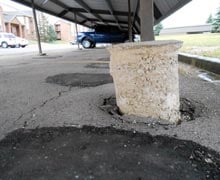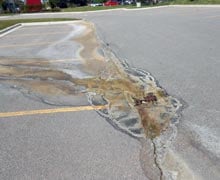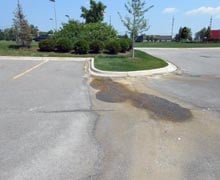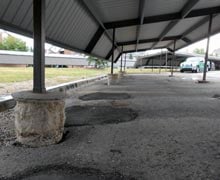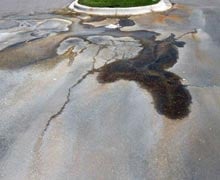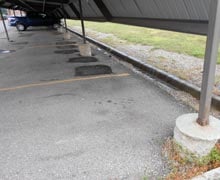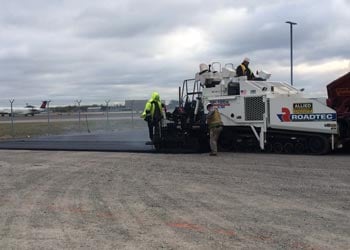
Maybe you have heard the expression, “Water Wins, Every Time”? Well, this is true for many construction and maintenance items. Our Southeast MI asphalt paving contractors know that pavement in particular, is very susceptible to water damage.
Pavement failure is most often caused by water beneath the surface.
According to studies, that are saturated just 10% of the time have a 50% reduction in actual useful life. In other words, keeping the pavement dry is very important.
Here’s how water affects asphalt parking lots and other paved surfaces.
Signs of Asphalt Water Damage
Standing water is more than just a surface issue—it’s a warning sign that your asphalt isn’t draining properly. When water pools on your driveway or parking lot for more than a day or two after rain, it points to underlying drainage problems. Asphalt cracks and potholes act like containers, trapping water and allowing it to seep into the layers beneath. This trapped moisture can weaken the foundation, and in colder climates, freeze-thaw cycles expand that water, creating even more cracks and structural damage.
Your asphalt may already be suffering if you have:
- Persistent puddles that linger for days after rainfall
- Deep cracks that seem to grow or multiply over time
- Sunken areas or depressions in the surface
- Potholes, especially ones that appear suddenly or expand quickly
- Loose gravel or crumbling edges near cracks or low spots
- Discoloration or soft spots that remain damp
If you're seeing any of these issues, it’s time for an inspection. Ignoring the signs can lead to costly asphalt repairs down the line, especially if the damage reaches the base layers. Our local asphalt paving contractors can assess the drainage and determine whether the foundation has been compromised. Addressing drainage problems early helps extend the life of your asphalt and keeps your surface safe and functional.
Examining Real World Examples
Take a look at the first photo in the small gallery below – these concrete carport footings are 12 years old and have been heaved over 30 inches out of the ground! REALLY!
Something like this is a real nightmare for the property manager and owners who have to solve it. How does this happen? If you guessed water, you are right! These footings did NOT extend below the frost line (typically 48 inches is standard for these and other types of posts).
How else ? A second photo below shows "dimples" from the static load of vehicle front tires. Front tires have heavier loads than the rear tires due to the engine being in the front of most cars. In these photos, the depressions are 3-5 inches deep.
The pavement also isn't compacting anymore. In fact, there is only 3 inches of pavement present. The wet subgrade underneath the paving cross section is mixing with the subgrade (clay) and in doing so it’s losing the ability to withstand loads. Particularly these heavy static loads that sit for long periods of time. The aggregate (stone) then gets forced down, and the clay moves upward. Ultimately, the paving loses its support and the depression occurs.
Related Post → What is Your Pavement Telling You?
Surface water leads to subgrade water. Not only will standing water cause damage to new pavements, but cracks will let in a large amount of surface water. That will then get into the subgrade and multiply the rate of subgrade failures.
Stopping water is a challenge. Since "water wins", controlling it and channeling it away from your pavement is critical to building a pavement that will be long-lasting.
Schedule Your Asphalt Repair Today
Our can help repair your pavement after water damage. We can even help you maintain asphalt so it’s built to withstand those wet months. Call one of our Allied Construction locations today or contact us online to get started with a free estimate!
This blog post has been updated.
